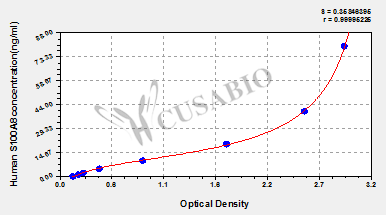The human S100A8 ELISA Kit is engineered for accurate measurement of human S100A8 levels from samples including serum, plasma, or tissue homogenates. It uses the Sandwich-ELISA mechanism in combination with the enzyme-substrate chromogenic reaction to measure the S100A8 content in the sample. The color intensity is positively correlated with S100A8 content in the sample. The S100A8 concentration can be calculated according to the standard curve. This kit is tested with high sensitivity, strong specificity, good linearity, high precision and recovery, as well as lot-to-lot consistency.
S100A8 binds to cell surface receptors that trigger signaling pathways to participate in the inflammatory process and plays a key role in multiple cellular processes, including cell survival, cell cycle progression, differentiation, proliferation, and cell migration. High expression of S100A8 has been found in various inflammation-related diseases like inflammatory bowel disease and solid cancers like breast cancer. S100A8 contributes to tumor growth, metastasis development, angiogenesis, and immune escape in a wide variety of solid cancers.






